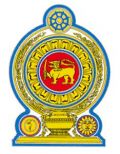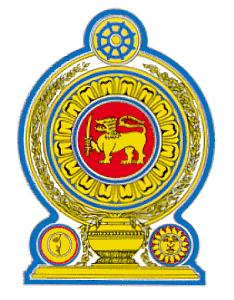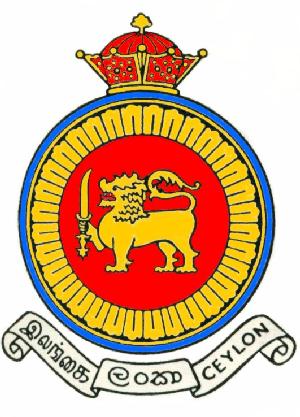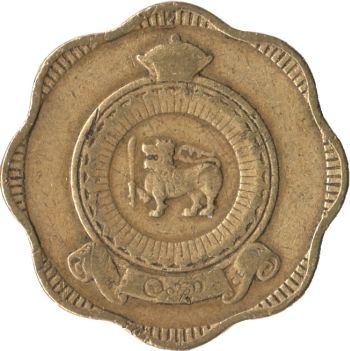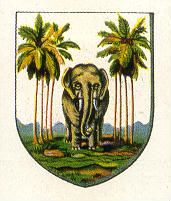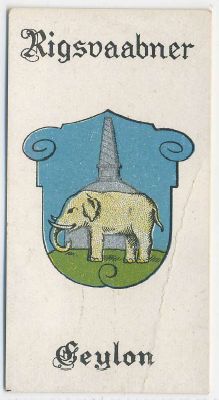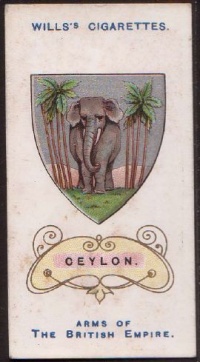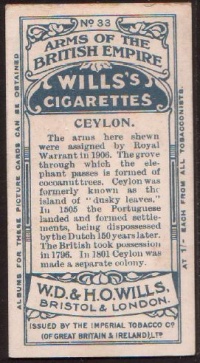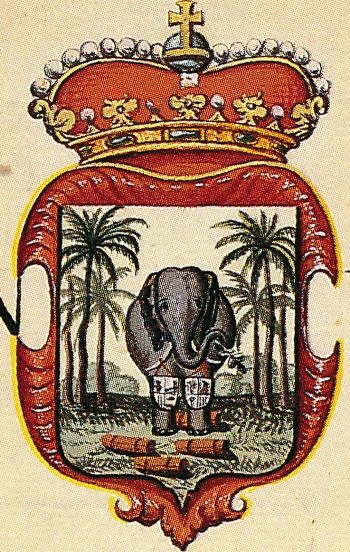National Emblem of Sri Lanka
Sri Lanka heraldry portal
This page is part of the Sri Lanka heraldry portal |
Heraldry of the World |
|
Civic heraldry:
|
Other heraldry: |
NATIONAL EMBLEM OF SRI LANKA
| English | blazon wanted |
Origin/meaning
The name Sri Lanka comprises the honorific Sri, or "venerable", and the island's proper name, Lanka. It is sometimes translated poetically as "resplendent isle".
The Republic of Sri Lanka, previously the Dominion of Ceylon, attained republican status within the Commonwealth of Nations on 22 May 1972. Its name in the Sinhala language (spoken by the majority of the country's population) is Sri Lanka Janarajaya.
The state arms, which are not in the heraldic tradition, reflect to an even greater extent than the arms of the Dominion of Ceylon (see below) the Buddhist traditions of the Sinhala-speaking people.
The Embklem of Sri Lanka incorporates the lion holding a sword, on a red roundel, within a circlet of lotus petals, from the 1954 arms of Ceylon.
Around the flower is a wreath of rice which sprouts from a pot on which the roundels rest. On either side of the pot are representations of the moon and the sun (drawn with faces), Buddhist symbols of longevity that are also found in the flag of Nepal.
Completing the design at the top, in place of the Kandyan crown that appeared in the Dominion arms, is a dharmachakra, or wheel of fate, also an important Buddhist symbol.
| The arms on a coin |
The arms of the Dominion of Ceylon (1948-1972)
Although not strictly in the heraldic tradition, the state arms of the Dominion of Ceylon were granted by the College of Arms in 1954. They largely reflect the Buddhist traditions of the majority Sinhala-speaking people.
The lion holding a sword (here called the Ceylon lion) appeared on the banner of the last king of Kandy (the last independent native state on the island). The banner was taken to Britain as war booty in 1815 and returned in 1948, following the creation of the independent Dominion of Ceylon on 4 February that year. (The island had been a British Crown Colony since 1802.)
The banner's design was initially used as the country's flag, but three years later stripes of green and orange were added in the hoist of the flag, to represent the island's Muslim and Hindu minorities.
The crown ensigning the roundel is called the Ceylon crown; it follows the design of the crown worn by the kings of Kandy. The crown apparently symbolised Queen Elizabeth as Head of State of Ceylon, and it disappeared from the country's arms after change of status to a republic.
| The arms on a coin |
The arms on a German matchbox label |
The arms of the Crown Colony of Ceylon (1796/1802-1948)
The arms of the Crown Colony of Ceylon were granted by Royal Warrant on 17 December 1904 and are blazoned:
Argent, on a mount Vert between a grove of eight coconut trees and mountains in perspective, an elephant affrontée, all Proper.
Ceylon, or the island of Sri Lanka, was a British possession from 1796, when British forces, to forestall any French move to outflank them, occupied the island in the name of Willem V, Prince of Orange and General Stadtholder of the Dutch Republic from 1751 to '95. Following the Treaty of Amiens, it was proclaimed a British Crown Colony in 1802, and retained that status until 4 February 1948, when it attained independence as a British Dominion.
The arms were based on the more detailed older Dutch arms, see below.
| The arms as shown on a German card, around 1900 |
The arms on a Danish tobacco card |
| The arms on a tobacco card ( 1910) |
(reverse) |
The arms of the Dutch Colony of Ceylon (1602-1796)
When the above arms for the Dutch colony of Ceylon were adopted is not known. The above image dates from a manuscript dating from 1717/1720.
The arms show the geography of the island with mountains and palm trees, with an elephant and cinnamon bales, and two small shields. The elephant symbolises strength and is a typical (work-)animal of the island. The cinnamon was the main export product. In front of the elephant are three bales of cinnamon, and the elephant holds a cinnamon branch in its trunk.
The two small shields are both quartered and show the arms of Colombo, Galle,Jaffna and Mannar, and the other the arms of Trincomalee, Matara, Batticaloa and Kalpitiya.
Contact and Support
Partners:
Your logo here ?
Contact us
© since 1995, Heraldry of the World, Ralf Hartemink 
Index of the site
Literature : Information provided by Mike Oettle, South Africa, images from www.cyber-flag.net (Sri Lanka), Mike Oettle (ceylon-dom) and Theo van der Zalm, Wageningen, the Netherlands (ceylon-cc); Silva, de and Beumer, Illustrations and views of Dutch Ceylon 1602-1796, 1988.
